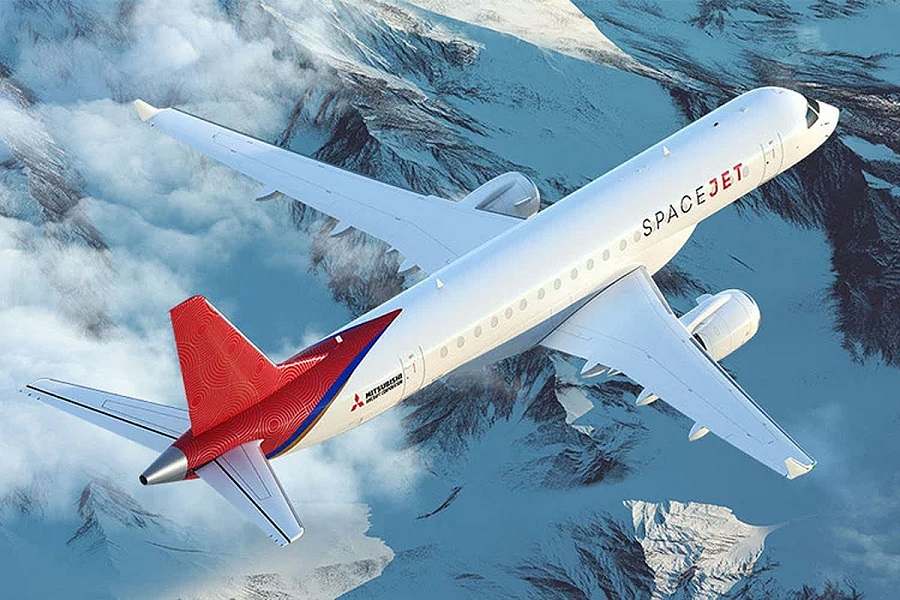Promising to be Japan’s first new airliner in over half a century, the crisis forces the Mitsubishi SpaceJet’s development aside – for now. It’s a difficult decision, for a project with 10 prototype aircraft already in the air and close to reaching certification. Originally known as the MRJ (Mitsubishi Regional Jet) programme, the Mitsubishi SpaceJet has already seen many delays.
Mitsubishi Heavy Industries is a fitting name for the company. It is active in multiple industrial fields, from automotive to shipping, military (including tanks!) and aviation. The Japanese government has supported the Mitsubishi SpaceJet project as a means to promote the aviation industry. While Japan has built various military aircraft over the years, the SpaceJet would be the first indigenous airliner since the NAMC YS-11 in the 1960s.
Originally, the intention was to design the aircraft as the first airliner using a 100% composite structure. Many years into the project the company’s engineers decided that the weight savings from carbon fibre were not substantial enough. The wing, wingbox and most of the fuselage will use aluminium as their source material. Composites will still be in use in the empennage and for smaller components.

The programme also faced delays with the brand-new and ultra-efficient Pratt & Whitney PW1000G geared turbofans. These pushed the first flight back by another two years. Then the company had to relocate most of its flying programme to the United States, due to heavy congestion in Japanese airspace.
Along with more minor delays, the programme has now seen 8 years of delays. The total development of the Mitsubishi SpaceJet has now cost the company nearly $9 billion.
Fighter Jet Replaces Mitsubishi SpaceJet?
With the Covid-19 crisis continuing, Mitsubishi decided to halt the SpaceJet project and switch focus on designing a new stealth fighter, with a mid-2030s deadline. Mitsubishi has built fighters before, namely F-15 and (highly modified) F-16 fighters for the JASDF, locally named the F-1 and F-2 respectively. And of course Mitsubishi were the makers of the A6M Zero. The SpaceJet will actually be built in a facility in the same location as the WWII naval fighter.
On October 30th the company announced halting the Mitsubishi SpaceJet. On the same day the Japanese government announced Mitsubishi as the company to lead development of the country’s next fighter. Mitsubishi has already built a concept aircraft known as the X-2, that flew in 2016. While not officially connected to the future fighter, the prototype had tested technologies intended for use in future agile jets. This is something the JASDF has been pushing for, for many years.
So it seems that the Japanese government still fulfills its wish to support local aviation manufacturing, with a temporary shift in direction. While Mitsubishi is far from abandoning the SpaceJet, halting the project seriously impacts many employees and external partners. The company already repatriated the flight testing programme to Japan earlier this year. This made sense, as the previously congested airspace, no longer was.

Limited Effects?
In all, the freezing of the regional airliner programme causes 2,000 job cuts outside the country. 3,000 jobs within the country will shift focus to other projects. Another 1,000 people will move to jobs with outside partners. It is not known how the situation affects other suppliers to the project, both locally and abroad. It is also not known how long this freezing of the project will last.
This of course affects customer airlines for the Mitsubishi SpaceJet. In previous years, long delays meant a lot of frustration between them and the manufacturer – sometimes in public. Customers for the jet include ANA in Japan, as well as SkyWest and Mesa Airlines in the US. Mitsubishi had modified the smaller of the two versions of the jet to better fit US desires for this category of aircraft – mainly for union-related reasons.
In the current climate, however, partner airlines probably won’t mind an additional delay. With airlines focusing their efforts on cost-cutting and reducing cash bleeding, routing new jets and training pilots and crews on them, can wait.
The Mitsubishi SpaceJet certainly is a good-looking aircraft. We will just have to wait a little bit longer before it graces the skies.
Links:
Images:



